Overview
Ranunculus also referred to as Persian buttercup is a gorgeous flower plant made up of excellent flowers that range in color from white to shades of pink, yellow and red. Ranunculus usually flowers in the spring but flowers may be found throughout the summer. Ranunculus is native to the Eastern Mediterranean region in southwestern Asia, southwestern Europe and northwestern Africa.
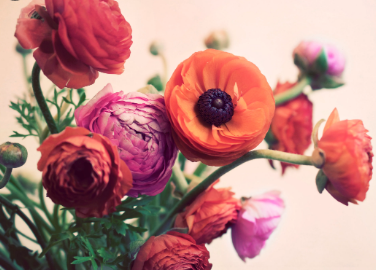
Plant Profile
| Botanical Name | Ranunculus asiatictus |
| Common Names | Ranunculus, Persian buttercup |
| Plant Type | Perennial flower (Bulbs) |
| Mature Size | 10 to 24 inches tall |
| Light Requirement | Full sun |
| Soil Type | moist and well-drained (loamy, clay, sand) |
| Soil PH | 6.0 to 6.5 |
| Temperature | Not more than 60oF during daytime and between 45oF and 50oF |
| Water Requirement | Regular Water |
| Bloom Time | Spring And summer |
| Bloom Time | Spring and summer |
| Flower Color | White, Pink, yellow, purple and red |
| Landscaping Ideas | Beds and boarders, patio and container |
| Hardiness Zones | 8 through 11 USDA |
| Native Area | Mediterranean |
| Gardening Style | Cutting garden |
| Spacing | 10 inches |
How To Perfectly Care For Ranunculus
Soil
Ranunculus requires moist but well-drained soils for effective growth. Well-drained soil is important for growing ranunculus because soils with excess moisture or waterlogged soils can result to crown disease or root rot. If your garden soil does not have a good drainage you can create raised beds by amending the native soil with enough organic matter or manure. To effectively amend the soil, cultivate the soil to a depth of 9 to 12 inches working organic matter into the planting bed.
Alternatively, you can consider growing your ranunculus in pots or containers. When growing in pots or containers use sand or loam soil and amend it with peat moss, vermiculite or perlite. Avoid planting your ranunculus in areas where puddles remain long after rainfall or if you know your soil is heavy clay.
Light Requirement
Ranunculus produces vibrant blooms when grown in an area that receives full sunlight. While selecting the best growing site for your ranunculus, consider a place where the plants can receive at least six hours of sunlight each day.
Fertilizer
Fertilizer application is very important to produce a gorgeous looking plant. You will need to apply a slow-release liquid fertilizer blend specifically designed for bulbs at least twice per month during the season of active growth. Ranunculus can suffer from iron and manganese deficiencies especially those growing in pots and containers. In this regard, use granular fertilizer or foliar fertilizer spray that contains iron and manganese.
Watering
Watering is very essential in especially for the Ranunculus plants grown in pots and containers. Always water the tubers after planting at least once after 14 days and when the first set of leaves appear on your plant, try to water them sparingly until fall comes around.
In the fall ranunculus usually die back or go dormant and during this period they do not need to be watered. Ranunculus tubers rot very easily in wet soil and therefore avoid over-watering. The soil should be allowed to dry out between watering routines.
Also, overwatering can results to foliar and root rot diseases which can kill the plant. Try to use a soaker hose or other form of ground watering to avoid over-wetting the soil. More importantly, avoid watering the flowers too once ranunculus begins to bud.
Mulch
Proper mulching results in healthier, more attractive and vibrant plants especially flowers. You will need to mulch around the ranunculus plant with between 3 to 5 inch layer of organic matter such as pine straw, cocoa hulls or pine bark. This will help to protect soil against moisture loss and reduce weed growth.
Mulching also protects the roots from winter temperature fluctuations and light frosts that can kill more tender plants. Early spring application of mulch can help keep the soil cool into summer.
Frost Protection
Frost is very dangerous for the survival of ranunculus plant. Ranunculus plants can effectively tolerate a light frost if left in the ground through a fairly mild winter. If you happen to be living in a climate that experiences heavy frost, store the pot/container growing plants inside the house away from heating appliances. If you have grown the ranunculus in a raised garden outside, you will need to dig up the tubers and store them in a cool place, till the frost danger goes away.
Deadheading Ranunculus
Deadheading is simply removing the dead flower heads from your ranunculus plant. Just like other flowers, ranunculus loses their attraction as they fade, spoiling the overall appearance of a garden or individual plant and in this regard, deadheading becomes absolutely necessary. Use a sharp pair of scissors to snip off the dead heads as soon as they begin to look dry, faded or dead.
Ranunculus Bulbs
Ranunculus grows effectively from bulbs with more corms that have claws on the bottom. The corm size predicts the number of flowers. The biggest bulb will produce up to 35 flowers while a number 1 bulb will produce up to 20 flowers, a number 2 bulb will produce up to 12 flowers whereas the number 3 bulb will produce up to 7 flowers.
How to Harvest Ranunculus Seeds
Usually, once the ranunculus flower begins to fade at the close of the season, a good number of seeds will at the same time be ripe for picking. Once the seedpods have changed from green to brown and can easily split, you can begin to collect the seeds.
Seed harvesting need to be done on a dry and sunny day. To collect the seeds, use a sharp garden scissor to cut the pods or seed heads from the plant and place them into a paper collection bag.
Propagation Of Ranunculus From Seeds
Generally, many gardeners prefer to grow ranunculus from tubers that they plant in fall; ranunculus can effectively be propagated from seeds. The seeds can be propagated in a garden bed or seed tray. Regardless of the method you go with, the seed should be propagated in a nutrient rich, loamy or sandy soil. Here is how you would proceed:
- Prepare your seedbed using a rake, tiller or a pitchfork until all the soil in the seedbed is loosened.
- Amend the loosened soil with organic materials such as well-rotten manure or compost. This helps to improve drainage, nutrients and promote growth.
- Bury the seeds in the garden and then lightly sprinkle the seedbed with water to keep the soil moist. The soil should always remain moist while the seeds are germinating.
- Your seeds should germinate within 10 days and 15 days.
- Alternatively, fill a flat seed tray half full of moist potting soil.
- Soak the seeds for at least 3 to 4 hours.
- Then, sprinkle the soaked over the soil on the seed tray and then cover them with more soil until they are completely covered.
- Place the tray in a cool place of temperature between (65-70oF) where rodents can’t find it.
- Keep checking the tray often and make sure that the soil remains moist until the corms begin to form.
- The seeds should germinate within 10 and 21days.
- When corms tubers/corms begin to form, remove any corms/tubers that show signs of rot or mold.
- Transplant the young plants into large pots when they have a couple of leaves.
Growing Ranunculus In Pots
Bulbs is the most efficient way to grow Ranunculus, you can grow it indoor in a planter or outside in a flower bed or garden. Usually moisture, sunlight and the proper soil are the most significant factors to growing ranunculus from bulbs.
- You need to find a planter or a container with sufficient drainage holes on it.
- Fill the container with a mixture of sandy soil, peat moss, vermiculite and perlite to create a well-drained soil, which is good for ranunculus. Alternatively you can mix the sandy soil with organic material or manure from your garden.
- Before planting, soak the tubers for between 3 to 4 hours in room temperature water.
- Plant tubers with the roots or fingers pointed downward at a depth of 1 to 2 inches (2.5-5 cm), depending on the size of the bulbs.
- Ranunculus plants tend to make large root system, therefore avoid crowding them too much in containers.
- Water the bulbs/tubers very well after planting, and then withhold water until growth appears to avoid rot.
- Once the plants are established, water sparingly throughout their period of growth.
Is Ranunculus Poisonous To Pets And Humans?
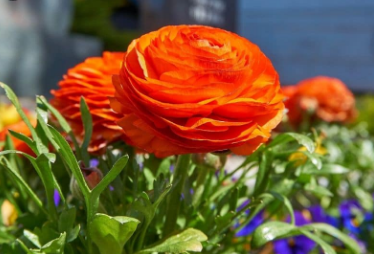
Generally, all varieties of ranunculus plants are harmful to livestock and can as well be poisonous to pets and people. The plant has unpleasant taste and cause blisters and sores to form in the mouth. As a precautionary measure, it is necessary to plant ranunculus in an area where livestock and pets are unable to reach the plant.
Common Pest And Diseases
- Aphids
- Root Rot
- Birds
- Powdery mildew
- Slugs
- Snails
Varieties Of Ranunculus
1. Ranunculus purple picotee

2. Ranunculus ‘Hanoi’
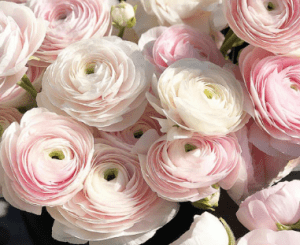
3. Ranunculus ‘Lyallii’

4. Ranunculus ‘Tango’
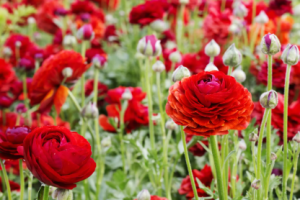
5. Ranunculus ‘Venere’

6. Ranunculus ‘Acris’

7. Ranunculus Alpestris

8. Ranunculus ‘Rhone pink’

9. Ranunculus ‘Cloni Dark Orange’
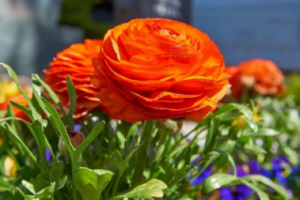
10. Ranunculus ‘Accolade’

Frequently Asked Questions (FAQ)
How Do Ranunculus Bulbs Look Like?
Ranunculus tubers look like spiders, claws or branches of bananas.
Is Ranunculus a Perennial or an Annual?
Ranunculus can be grown as both a perennial and an annual. The Ranunculus is classified as perennial in the United States in hardness zones 6 through 11, depending on the specific species. It is possible to grow ranunculus as annuals outside those zones.
How Long Do Ranunculus Flowers Last?
Fall-planted corms bloom in early spring and continue steadily for six to seven weeks. Late winter-planted corms will flower by mid-spring and continue for four to six weeks.
When Is The Best Time To Plant Ranunculus Bulbs?
Irrespective of the region you live and many other factors that affect perennials, you can plant your ranunculus in either fall or late winter or early spring after the danger of frost has passed. Whereas the spring planted bulbs won’t be vigorous as the fall planted ranunculus, either way, there will always be a good harvest provided the plants receive adequate care and attention.
When Is The Best Time To Replant Ranunculus Bulb Outside?
Replant the buttercups outside when all danger of frost has passed and the first true leaves are evident.
When Do You Dig Ranunculus Bulbs?
Dig out the tubers when the foliage is dry and dead. Save the ranunculus over the winter especially in areas prone to freezing, because ranunculus are extremely sensitive and will not survive much more than a light frost.
What Is The Best Size Of The Ranunculus Bulbs One Should Buy
Always buy the largest tuber size available, commonly referred to as Jumbos because they will be vibrant and the flowers will be larger. Bigger tubers will produce 10 to 12 stems in a growing season and as many as 35 flowers.
How Do You Store Ranunculus Bulbs?
Ranunculus bulbs are prone to rotting if storage is not done as it is required. Storing ranunculus tubers is quick and easy; however, there are few tips that must be observed in this regard for the tubers to have enough energy to bloom the following year.
Dig out the tubers when the foliage is dry and dead. Cut off the leaves and allow the tubers to dry completely for a couple of days either indoors in a warm low humidity room or simply out in the sun. After the tubers are dry, store them packed in dry moss, such as peat in a mesh bag. Moreover, after the cold season has passed, you can now start the tubers and plant out when the soil is warm and workable.
How Do You Use Ranunculus?
Medium-sized growth and Straight stems are the major features of Ranunculus; these make them suitable for container plantings, boarders, cutting, cutting gardens and mixed perennial gardens.
Is Ranunculus Tolerant To A Wide Range Of Environmental Conditions?
Well, just like majority of tubers, ranunculus can adapt to a wide range of growing conditions as long as you give them full sun, sufficient moisture and soil with good drainage.
Are Ranunculus And Peonies The Same?
Ranunculus belongs to a family of buttercups whereas peonies belong into their own family referred to as Paeonia. The ranunculus is similar to peonies but the main difference between ranunculus and peonies is, the bloom size is a bit smaller and the flower has a flatter shape.
I love the Ranunculus flowers! The more vibrant, the better. I actually recently wondered whether ranunculus could be grown outside of a greenhouse and you just confirmed that they can. Forwarding this to my sister, who has a lovely garden that needs more gorgeous flowers.